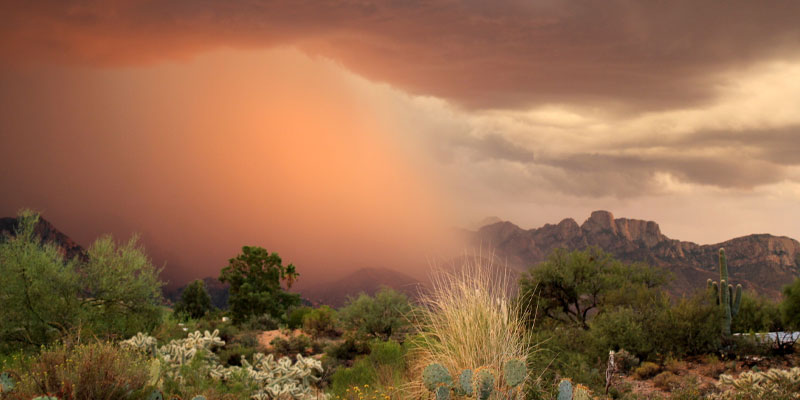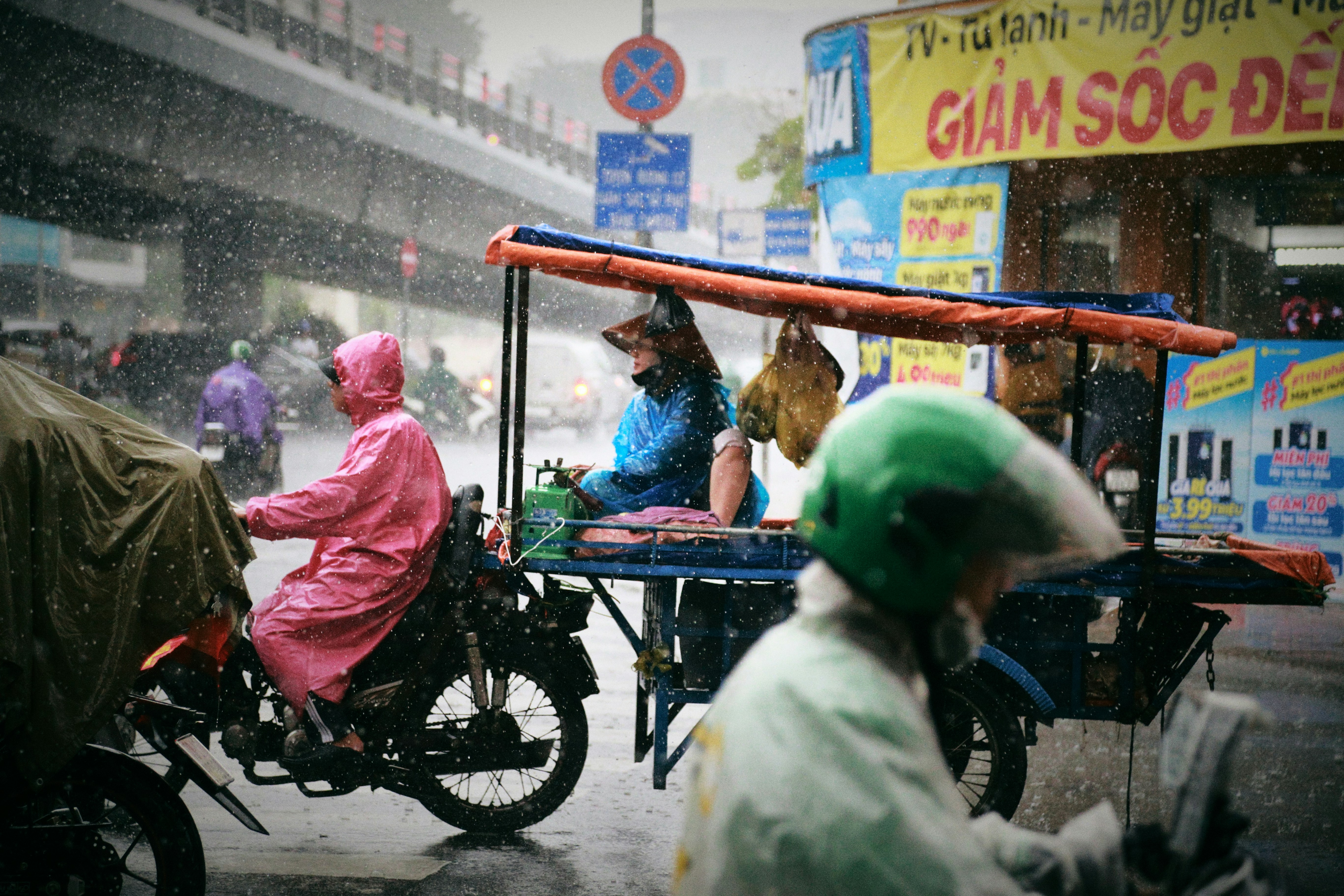Intense monsoon events bring heavy, unrelenting precipitation that can trigger flash floods, landslides, and soil erosion, causing immense damage to natural habitats and infrastructure.
This article explores the different types of monsoon weather phenomena, their characteristic features, and their wide-ranging impacts on the environment, from transient disturbances to long-term effects on ecosystems and biodiversity.

Jump to:
What is a Monsoon?
A monsoon is a seasonal shift in wind patterns and precipitation. They are caused by temperature differences between the land and ocean, resulting in a distinct wet and dry season in the affected regions.
During the summer months, warm continental air rises, allowing moist winds from the ocean to travel inland and bring heavy rain. Then, in winter, the cycle reverses, with dry continental winds pushing back out towards the ocean.
For example, in the Indian subcontinent, the summer monsoon begins in May/June. As winds sweep in from the Indian Ocean, there is heavy rainfall which continues until around September. The winter monsoon then runs from October to April, when cold and dry winds from the land are blown back towards the Indian Ocean, creating very dry conditions.
Historically, the arrival of the summer monsoon was celebrated as a life-giving annual event, especially in areas that depended on the rain for agriculture. South Asia, Southeast Asia, and parts of Africa have festivals and rituals to celebrate this monsoon.
Recommended for you!
Best SellersTypes of Extreme Monsoon Weather
Many people assume monsoon weather simply brings a lot of rainfall over a period of a few months. Although this is true, the consequences of such heavy rainfall can be severe and devastating.
Heavy rainfall
The monsoon is characterised by periods of intense and relentless rain over a relatively short period of time. While this is vital for agriculture and water reserves, it can also wreak havoc. Roads, railways, and housing in low-lying areas face the risk of inundation and damage. Crops can also be destroyed by excessive rainfall and waterlogging of fields. In Asia, this is particularly common; the Indian states of Assam and West Bengal face annual torrential rain from the summer monsoon. The city of Mumbai has also experienced catastrophic flooding, as well as Bangladesh.
Flooding
While heavy rains are expected, the sheer volume of precipitation can cause rivers to overflow, leading to devastating floods. Even storm surges from tropical cyclones interacting with the monsoon can cause extreme flooding. Large stretches of land across South and Southeast Asia face annual inundation. The monsoon floods of 1998 submerged vast areas of Bangladesh, and in 2017 intense monsoon currents in the Indian Ocean triggered floods across Nepal, Bangladesh, and India, impacting over 40 million people.
Landslides
The consistent rain can cause hills and slopes to become unstable, triggering landslides. The added weight of the accumulated precipitation, combined with erosion and weakening of the soil's structural integrity, can cause entire hillsides to collapse catastrophically. These types of landslides are capable of burying homes, destroying roads and causing widespread destruction in their path. Areas that are more vulnerable are those which have been previously deforested or that have poor drainage systems.

Impact on the Environment
While monsoons play an important role in replenishing water sources and supporting agriculture, they can also have a severe impact on the environment and ecosystems, triggering intense rainfall, flooding, and landslides that can destroy habitats and displace many species of animals and plants. Aquatic life can suffocate under the influx of water and sediment, while strong currents can wash away the vegetation along riverbanks. On land, the force of the rains and mudslides can strip away soil and vegetation that’s crucial for the survival of some species. Even after the monsoon passes, the landscape may remain uninhabitable for its former occupants.
Unfortunately, as species struggle to adapt or find new and suitable environments to live in, this leads to biodiversity loss. Over time, recurring extreme monsoon seasons can permanently reshape ecosystems, altering landscapes and hydrology and reducing populations of key species. Ecosystems with high biodiversity and redundancy in ecological roles tend to be more resilient and better equipped to withstand climatic shocks. However, even they have their limits, especially in the face of unprecedented monsoon disasters driven by climate change.
Monsoons in Asia
The behaviour of monsoon patterns varies significantly from region to region across Asia. One of the key differences lies in timing. Monsoon seasons onset at different times throughout the year, with some regions experiencing early rainfall while others wait until later. For example, countries in South Asia (such as India, Bangladesh, Nepal and Pakistan) experience a predominant southwest summer monsoon from June to September. However, the Western Ghats and Himalayan ranges influence the distribution and intensity of precipitation, with some areas receiving exceptionally high rainfall while others remain relatively dry.

On the other hand, Southeast Asia (including countries like Thailand, Vietnam, and the Philippines) encounters a more complex monsoon pattern with distinct regional variations. The southwest monsoon from May to September affects the Indochina peninsula and the western regions, while the northeast monsoon from November to March dominates the eastern maritime areas. The timing and strength of these monsoons are influenced by factors such as the El Niño-Southern Oscillation (ENSO) and the positioning of the Intertropical Convergence Zone (ITCZ), which is an area of low pressure located around the Earth’s equator.
In East Asia, countries like China, Korea and Japan experience their own distinct warm and humid summer monsoon from May to August and a cold, dry winter monsoon from November to March. Their monsoons are shaped by the temperature contrasts between the Asian landmass and the Pacific Ocean, as well as the topography of the Tibetan Plateau and the Himalayas.
Factors like the presence of mountain ranges, proximity to the ocean and sea and atmospheric conditions like the strength and position of the ITCZ (Intertropical Convergence Zone) and jet streams all contribute to the regional variability of monsoons across Asia.
Discover the Intricacies of Weather Patterns with Centre of Excellence
Dive into the dynamics of the atmosphere with our Meteorology Diploma Course, designed to demystify the complexities of weather and climate change.
Why Choose Centre of Excellence?
- Inclusivity: We believe knowledge should be accessible to all. That's why we've priced our courses to be affordable, ensuring everyone has the opportunity to learn.
- Learn on Your Terms: Our courses are designed to fit into your life. With the flexibility to study at your own pace, you can seamlessly incorporate learning into your busy schedule.
- Diverse Curriculum: Explore the broad spectrum of meteorology, from fundamental principles to advanced concepts in climate change. Our course caters to a wide range of interests and levels of expertise.
- Dedicated Support: Enrolment comes with personalised tutor support and access to a community of like-minded learners. You're never alone on your educational journey.
Special Invitation
We're excited to offer our Meteorology Diploma Course at the special price of £29 (save £98!), providing a substantial saving. Learn all there is to know about extreme weather events like jet streams, thunderstorms, tornadoes and more!













